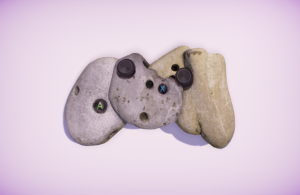 “I’m trained as an architect, but I tend to make human-sized and physically embodied, interactive video games. The work that I do is inherently spatial and performative. These video games often involve playful, participatory props and room-scale installations. This gives space for interaction, play, roleplay, time and scale shifts, among so much else.
“I’m trained as an architect, but I tend to make human-sized and physically embodied, interactive video games. The work that I do is inherently spatial and performative. These video games often involve playful, participatory props and room-scale installations. This gives space for interaction, play, roleplay, time and scale shifts, among so much else.
If you think about it, oftentimes when you’re dealing with video games or with virtual reality, they’re inherently screen-based and flat, even when they are fully immersive. And as you experience them, you’re engaged with and entrapped within a digital space, despite literally being within a physical space. My work is actually leaking that digital space out back into the physical space and starting to think about how we engage both simultaneously. How one speaks to another. How we interact in that weird, dynamic space, today is often referred to as Mixed and Extended Reality.
I found my way into architecture initially through woodworking because I wanted to make things with my hands again after spending my first semester of university in an honors mathematics program. Going to school for architecture was an amazing preparation for working in design, fabrication and in the world at large. From there, I worked many different jobs: everything from exhibition design and build-out to the editing and graphic designs of books, to working in architecture firms on building projects.
I have a history of concussions from growing up competitively snowboarding. In between the internships and jobs, I realized pretty quickly that I actively could not sit in front of the computer for more than three hours at a time. And often what’s called for when you’re working in architecture is hours and hours in front of a computer iterating on building designs. So, I needed to find another way to work, because working this way was toxic to my health and being.
 At an art exhibition in New York City, I entered a series of spaces built for viewing the video game simulation work of the artist Ian Cheng. Here something clicked for me. I went into architecture because I like materials and I like buildings, and when you go into a good building, it feels good for your body and your head opens up and feels lighter with the space, because the space in its design, scale and details is so right. This is what happened for me when I was in Ian’s live simulation spaces. It was an ‘A-ha’ moment for me where I was like, ‘This is something inherently spatial and it’s also inherently immersive and interactive.’
At an art exhibition in New York City, I entered a series of spaces built for viewing the video game simulation work of the artist Ian Cheng. Here something clicked for me. I went into architecture because I like materials and I like buildings, and when you go into a good building, it feels good for your body and your head opens up and feels lighter with the space, because the space in its design, scale and details is so right. This is what happened for me when I was in Ian’s live simulation spaces. It was an ‘A-ha’ moment for me where I was like, ‘This is something inherently spatial and it’s also inherently immersive and interactive.’
From there, I started experimenting with video game engines. Because I couldn’t just sit in front of a computer, I started working with virtual reality equipment and attempting to hack it, to leverage its spatial computing and tracking capabilities for non-normative uses. I was working to create a process where my work and time on the computer was broken up by things like working in a woodshop, welding, spraying or cutting foam—physical making. So not only are the video games interactive, but my process inherently is also interactive.
I make physical and digital objects, spaces and interactions not to emphasize some seamless, conservative digital twinning or erasing of what we already know and find ourselves surveilled and oppressed by in every corner of life, but something much more oppositional and frictional; I’m interested in play, making and having fun, discordance as well as synchrony, space making and taking, collectivity, absurdity, liberation, failure, misuse and mess.
I’m not really interested in the typical VR setup alone, as some isolated, alone together, screen and productivity-bent space, such as is fairly evident in the remarketing of the Metaverse by Mark Zuckerburg. I’m interested in a much more critical take and thinking about how we want to leverage spatial technologies towards alternative futures that are more nuanced, open and playful in nature.”
— Leah Wulfman, a new faculty member in the College of Architecture + Planning
